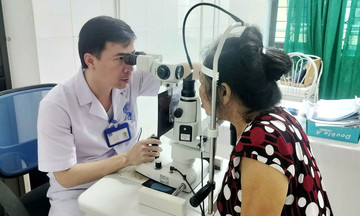He points to a faded black-and-white photo of a skinny, straw-hat-wearing teenager, saying slowly, "This is my eldest son," then pauses, "what year was it again?" His eldest, Hung, now in his seventies, reminds his father, "the year of the B52 evacuation," referring to the 1972 "Dien Bien Phu in the Air" bombing campaign by American B52s over Hanoi.
Khanh and his wife were business owners and had 8 children—4 sons and 4 daughters. His youngest daughter is now over 50. Fortunately, the war and hardships of that era didn't claim any of his children. Each of his children married young and had 3 to 5 children, and then his grandchildren married and had 2 to 3 children each. Now, counting children, grandchildren, and great-grandchildren, Khanh has nearly 100 descendants, with the largest group aged between 30 and 50. Every year on the anniversary of his wife's death, his five-generation family gathers at his 5-story house, filling 10 tables, with not enough room for everyone.
Khanh’s wife passed away over 5 years ago, and he now lives with his eldest son in a three-generation household. As time passes, each family gathering reveals more gray hair around the table, with fewer children present. Many of Khanh's great-grandchildren are married with only one child, and some of his great-great-grandchildren don't even want to get married.
"In my generation, having many children was seen as patriotic, providing a workforce. Now, young people are different; we urge them to get married, but they won't," Khanh says, noting that his descendants' lives are much easier than his and his children's were.
Khanh's family isn't alone in experiencing these generational shifts. Many other families in his village and across the country have seen similar changes. These family transformations contribute to societal and national changes, most notably in population dynamics.
 |
Children in Hanoi in front of St. Joseph's Cathedral on Christmas Eve 2024. Photo: Giang Huy |
Children in Hanoi in front of St. Joseph's Cathedral on Christmas Eve 2024. Photo: Giang Huy
From "encouraging births" to promoting birth reduction
"In the 1960s, the average Vietnamese woman had about 7 children by the end of her childbearing years. By the 21st century, the birth rate had significantly decreased," Professor Nguyen Dinh Cu, former Director of the Institute of Population and Social Affairs at the National Economics University, a veteran demographer, told VnExpress on the occasion of the 80th anniversary of the August Revolution and National Day, 2/9.
In 1945, Vietnam had a small population of around 23 million. The average life expectancy was less than 40 years, with many deaths due to war, disease, and malnutrition. Today, the population has grown significantly, exceeding 100 million, with a high population density. According to the General Statistics Office, Vietnam's population on 1/4/2024 was 101,112,656, ranking 15th globally, 3rd in Southeast Asia (after Indonesia and the Philippines), and larger than the combined population of Brunei, Cambodia, Laos, Malaysia, Singapore, and East Timor.
The period from 1954 to 1975 was a "baby boom" era in Vietnam. Professor Cu explains that people "tried their best to have children" due to the belief that "nature will provide," without prioritizing quality. The government had no population policy or family planning programs. People were not educated about or provided access to contraceptives like condoms or IUDs.
Faced with low population quality, overburdened healthcare, educational pressures, high infant mortality, famine, war, and economic hardship, the government decided in 1961 to implement "guided childbirth," marking the beginning of population control efforts in Vietnam. The population continued to grow, reaching nearly 50 million by 1976. After the war, population issues received greater attention, and the government adopted a "one or two children per couple" policy to reduce births.
Mai Xuan Phuong, former Deputy Director of the Department of Communication and Education at the General Department of Population (now the Department of Population, Ministry of Health), believes that the period between 1991 and 2000 marked a "new chapter" in Vietnam's population history. People began to embrace family planning. Population officials "went door-to-door, reaching every household and individual" to promote family planning and distribute condoms. The government encouraged families to have only 1 or 2 children, and party members who had a third child faced disciplinary action.
In Nam Dinh, a livelihood village became a "model village" for the national family planning movement. In the 1990s, families there averaged 5 to 6 children. Initially, people resisted family planning efforts. However, after 5 years of persistent promotion of the slogan "raising 2 children well is better than 6 children facing constant hunger and uncertainty," the village transformed into a "model livelihood village" with each family having 2 children.
These efforts helped Vietnam achieve replacement fertility (2.09 children per woman) in 2006, similar to Japan in 1961 and South Korea in 1985. The birth rate has continued to decline each year since. The average number of children per mother has decreased, leading to a lower crude birth rate (the number of live births per 1,000 people) and a significant drop in the annual number of births. In 1989, the country had a population of 64 million with over 1.9 million births. In 2024, the population increased to over 101 million, but only 1.3 million children were born, a decrease of 600,000 births compared to 35 years earlier.
"Childbearing has shifted from a natural, instinctive act to a planned, civilized one; from passive to active; from high quantity and low quality to low quantity and high quality; and from less responsible to more fully responsible. This is truly one of the most profound social transformations in Vietnam," observes Professor Cu.
Since 2018, the birth rate has fallen below the replacement level. In 2024, it reached a record low of 1.91 children per woman of childbearing age. Vietnamese women now have less than one-third the number of children they did half a century ago. The population growth rate has also decreased from over 3.3% per year between 1955 and 1965 to 0.8% in 2024.
The low birth rate profoundly impacts the population structure, shrinking the working-age population, accelerating aging, and negatively affecting population size. Experts worry that without timely intervention, Vietnam could face a "population collapse," crippling the economy.
Adapting to aging
Vietnam's population is aging rapidly, with the number and proportion of elderly people constantly increasing. According to statistics, Vietnam entered the aging phase in 2011 and is projected to become an "aged population" by 2038. Notably, this transition will take only 27 years (2011-2038). In comparison, it took France 115 years, Sweden 85 years, Australia 73 years, the US 69 years, and Japan 26 years.
"This shows that the pace of aging in our country is very rapid and much faster than in developed countries," says Professor Cu.
Population aging is a challenge for population management, impacting economic growth, social welfare, labor, infrastructure design, and especially healthcare. It reduces the working-age population, changes occupational structures, and increases the economic burden on younger workers.
In the 21st century, Vietnam is experiencing unprecedented population trends that have both positive and negative impacts on the country's rapid and sustainable development. Therefore, it's crucial to incorporate these trends into socio-economic development policies and strategies to seize opportunities and overcome challenges.
"In other words, it's necessary to legalize the assessment of population impact in all socio-economic development plans," proposes Professor Cu.
In response, the Ministry of Health is developing a Population Law and a Target Program for Healthcare, Population, and Development for the period 2026-2035. The draft law proposes priorities to encourage births, reduce the sex ratio at birth, and adapt to the aging population, such as increasing maternity leave and providing cash or gifts for newborns.
Minister of Health Dao Hong Lan stated that the draft law, after being appraised by the Ministry of Justice, is expected to be submitted to the Government for presentation to the National Assembly for feedback and potential approval at the 10th session (10/2025).
While awaiting the legalization of pro-birth policies, Khanh's great- and great-great-grandchildren remain hesitant about having more children or even getting married. "I told my children that if their children have more kids, they can bring them here for us to care for so they can focus on their careers, but so far, our dining table is filled only with adults," says Khanh's eldest son.
Le Nga












